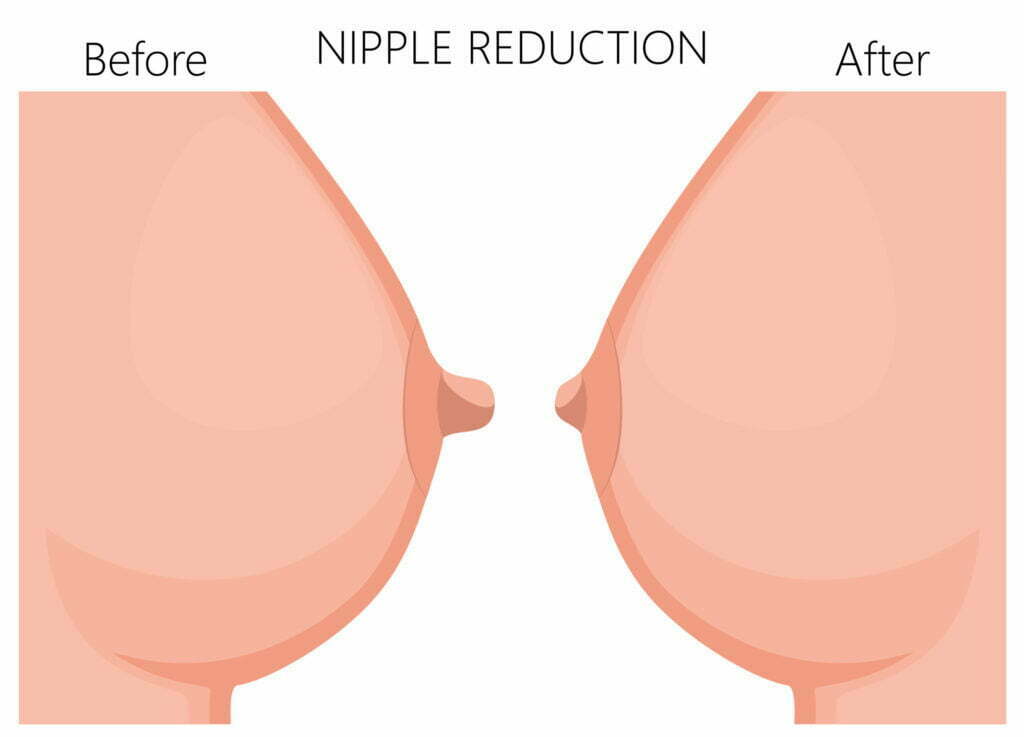Nipple Reduction Surgery & Breastfeeding: What to Expect
Posted on: April 3, 2024
Understanding Nipple Reduction Surgery
Cosmetic Goals
Nipple reduction surgery primarily aims to alter nipple size for cosmetic reasons. Patients often seek this procedure to feel more comfortable with their appearance.
The goal is a more proportionate look. This boosts confidence and satisfaction with one’s body image.
Surgical Techniques
Surgeons use specific techniques during nipple reduction. They might remove excess tissue or resize the areola.
This process ensures the nipple blends seamlessly with the breast’s overall shape. Precision and care are vital to maintain natural aesthetics.
Breastfeeding Impact
A crucial aspect of nipple reduction is its potential effect on breastfeeding. The surgery can impact milk ducts, which are essential for lactation.
Prospective patients should consider this carefully. Discussing concerns with a surgeon before deciding is crucial.
Nipple Reduction Surgery Cost
Cost Range
The typical cost range for nipple reduction surgery varies widely. It can span from $1,000 to $5,000. This broad spectrum depends on factors like location, surgeon’s expertise, and the complexity of the procedure.
Patients should understand that this is an out-of-pocket expense. Most health insurance plans view nipple reduction as aesthetic. Thus, they do not cover it.
Insurance Coverage
Insurance companies often classify nipple reduction under cosmetic procedures. As a result, they rarely cover these costs. It’s crucial for individuals to review their policy details. They should also talk directly with their insurance provider.
This clarification helps avoid unexpected financial burdens post-surgery.
Price Comparison
It’s wise to consult multiple clinics before deciding on a surgeon. Doing so allows potential patients to compare prices and financing options.
e clinics offer payment plans or partnerships with financing companies. These options can make the procedure more accessible for those who cannot pay upfront.
Breastfeeding Ability Post-Surgery
Surgery Impacts
The type of nipple reduction surgery can greatly influence a woman’s ability to breastfeed. Techniques that preserve the breast tissue and maintain a good blood supply are crucial. These factors ensure that milk production is not hindered.
Surgeries that alter the pedicle width or location can affect lactation. A narrower pedicle might restrict blood flow, essential for milk production. Surgeons aim to protect the pedicle characteristics to safeguard breastfeeding capabilities.
Duct Damage
One significant risk of nipple reduction is damage to the milk ducts. This can lead to reduced milk flow or blockages. Plastic surgeons skilled in preserving the integrity of these ducts can minimize such risks.
It’s vital for those considering this surgery to understand that any interference with breast anatomy carries a risk. However, careful surgical planning can reduce potential harm to breastfeeding abilities.
Discussing Intentions
Patients should discuss their breastfeeding intentions with their surgeon before undergoing nipple reduction. This conversation ensures that the surgeon selects a technique that supports future breastfeeding plans.
Understanding the cost implications from the previous section is also important. Patients must weigh these costs against the potential impact on breastfeeding. Making an informed decision involves considering both financial and health-related aspects.
Preparing for Breastfeeding After Surgery
Surgery Impact
After undergoing nipple reduction surgery, time is crucial for healing. Experts recommend waiting a minimum of three years post-surgery before attempting pregnancy. This period allows the tissue to heal properly and minimizes complications.
It’s vital to inform healthcare providers about your surgery when planning for pregnancy. They can offer tailored advice and monitor your healing process closely.
Lactation Consultation
Consulting lactation experts early is key. They prepare you for potential breastfeeding challenges due to the surgery’s impact on the tissue. Early engagement with a lactation consultant can equip you with techniques and tools to facilitate breastfeeding.
Lactation consultants also provide emotional support, making the journey less daunting. Their expertise can be invaluable in navigating the complexities of breastfeeding after surgery.
Can You Breastfeed After Nipple Reduction
Milk Supply
Breastfeeding after nipple reduction is often possible. However, success depends on the surgery’s extent. Some women find their milk supply unaffected. Others notice a decrease.
It’s crucial to monitor baby’s weight gain and consult a lactation expert if concerns arise. They can offer strategies to increase milk production.
Nipple Sensitivity
Changes in nipple sensitivity can impact breastfeeding. Some women experience increased sensitivity, making nursing uncomfortable initially. Others may have reduced sensation, which could affect the baby’s latch.
Practicing different breastfeeding positions can help find a comfortable setup for both mother and baby.
Communication with Doctors
Open dialogue with healthcare providers is key. Discuss breastfeeding goals before surgery to tailor the procedure accordingly.
After surgery, seeking support from lactation consultants is beneficial. They can provide personalized advice and reassurance during the breastfeeding journey.

Process of Breastfeeding Post-Surgery
Feeding Adjustments
After nipple reduction surgery, breastfeeding might require adjustments. Mothers may need to experiment with different breastfeeding positions to find what’s most comfortable and effective for both them and the baby. The cradle hold or side-lying position often works well, as they allow for easy adjustment of the baby’s latch.
It’s crucial for mothers to be patient and persistent. Initially, babies might struggle to latch properly due to the changes in nipple shape or sensitivity. Using a breast pump can help stimulate milk production and maintain supply until the baby adapts to breastfeeding post-surgery.
Lactation Support
Seeking help from a lactation consultant is invaluable after undergoing nipple reduction. These professionals can provide personalized advice on overcoming common breastfeeding challenges. They offer techniques to improve latch, suggest ways to increase milk production, and guide on using breastfeeding aids if necessary.
Lactation consultants also serve as a support system, offering encouragement during what can be an emotionally taxing time for new mothers struggling with breastfeeding post-surgery.
Monitoring Progress
To ensure babies receive enough milk post-surgery, closely monitoring their feeding patterns and weight gain is essential. Look for signs of adequate milk intake:
- Regular wet and dirty diapers
- Consistent weight gain according to pediatric guidelines
If concerns arise about the baby’s weight gain or milk intake, consult with a pediatrician immediately. They can assess whether supplementary feeding is needed and provide guidance on maintaining the health and development of the baby.
Enhancing Breastfeeding Experience
Milk Supply
To boost milk production, frequent nursing is key. It stimulates the milk ducts and signals the body to produce more milk. Pumping between feedings can also maintain a full milk supply.
Mothers should aim for exclusive breastfeeding when possible. This means relying solely on breast milk for the infant’s nutritional needs. Various factors influence this process, including the health of the mother and infant, as well as psychosocial factors.
Supportive Environment
A nurturing environment significantly impacts successful breastfeeding. Family and healthcare providers play crucial roles. They offer care, support, and necessary interventions if challenges arise.
Breastfeeding aids like nipple shields or pumps might be recommended by a lactation consultant. These tools can help preserve the breastfeeding relationship while addressing specific issues such as latching difficulties or soreness.
Emotional Support
Joining a breastfeeding support group offers both emotional and practical benefits. Mothers share experiences, advice, and encouragement with one another.
These groups often provide valuable data extraction from personal stories. They highlight common concerns and effective strategies for overcoming obstacles to breastfeeding post-surgery.
Supporting Breastfeeding After Surgery
Patience Required
Breastfeeding after nipple reduction surgery can be challenging. The surgery may affect the milk ducts, which are crucial for milk flow. However, many women successfully breastfeed with time and patience.
It’s essential to start early and be persistent. Challenges may arise, but they often diminish as both mother and baby adapt. Seeking early support can make a significant difference in this journey.
Professional Help
Lactation consultants play a pivotal role post-surgery. They offer tailored strategies to overcome breastfeeding hurdles. Their expertise can help protect the milk supply while ensuring the baby receives adequate nutrition.
Pediatricians also monitor the baby’s weight gain and overall health. They ensure that any issues related to feeding are addressed promptly. Together, these professionals form a support network that is invaluable for new mothers navigating breastfeeding after nipple reduction.
Community Support
Sharing experiences with other mothers who have undergone similar surgeries can be incredibly supportive. It fosters a sense of community and provides practical tips that only those who have been through the process can offer.
Online forums and local support groups are great places to connect with others. Hearing success stories can boost confidence and provide reassurance that successful breastfeeding is possible post-surgery.
Final Remarks
Navigating the journey of nipple reduction surgery and breastfeeding is a path filled with decisions, but armed with the right information, you can make choices that best suit your body and your baby. Understanding the surgery, its costs, and its implications on breastfeeding are crucial steps in preparing for what lies ahead. If you’re considering this surgery, remember it’s possible to breastfeed successfully with proper preparation and support.
Breastfeeding after nipple reduction is a topic surrounded by questions and concerns, yet many find ways to nourish their babies effectively. By focusing on preparation, embracing the process, and seeking support when needed, you can enhance your breastfeeding experience. If this is a journey you’re about to embark on, reach out to healthcare professionals who can guide you through each step. Your commitment to understanding and preparing for breastfeeding post-surgery can lead to a fulfilling experience for both you and your baby.
Frequently Asked Questions
Can I breastfeed after nipple reduction surgery?
Yes, most individuals can breastfeed after nipple reduction surgery. However, it depends on the specific techniques used during the procedure and the extent of the surgery.
What is the cost of nipple reduction surgery?
The cost of nipple reduction surgery varies depending on the surgeon’s experience, geographic location, and the specifics of the procedure. It’s best to consult with a plastic surgeon for an accurate estimate.
How does nipple reduction surgery affect breastfeeding ability?
Nipple reduction surgery may impact your ability to breastfeed, depending on how much tissue is removed and which ducts are affected. Consulting with your surgeon about your desire to breastfeed is crucial before undergoing the procedure.
How should I prepare for breastfeeding after nipple reduction surgery?
Preparing for breastfeeding after surgery involves discussing your plans with your surgeon, understanding potential impacts on milk supply, and considering consultation with a lactation expert for personalized advice and support.
What is the process of breastfeeding post-surgery?
Breastfeeding post-surgery might require patience and persistence. It’s important to monitor your baby’s weight gain and seek support from a lactation consultant to address any challenges that arise due to changes in nipple sensitivity or milk supply.
How can I enhance my breastfeeding experience after surgery?
Enhancing your breastfeeding experience involves staying hydrated, maintaining a healthy diet, using comfortable breastfeeding positions that work for you and your baby, and seeking emotional support from family or breastfeeding groups.
What support is available for breastfeeding after surgery?
Support options include lactation consultants who specialize in post-surgical breastfeeding challenges, online forums where you can share experiences with others who’ve had similar surgeries, and local breastfeeding support groups offering encouragement and practical tips.



